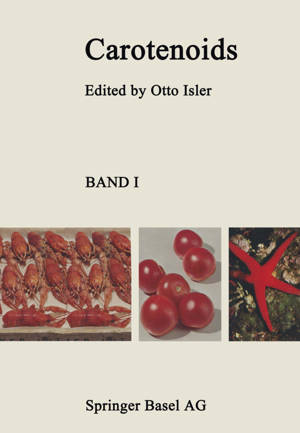
- Afhalen na 1 uur in een winkel met voorraad
- Gratis thuislevering in België vanaf € 30
- Ruim aanbod met 7 miljoen producten
- Afhalen na 1 uur in een winkel met voorraad
- Gratis thuislevering in België vanaf € 30
- Ruim aanbod met 7 miljoen producten
Zoeken
Carotenoids
Paperback | Duits | Lehrbücher und Monographien aus dem Gebiete der exakten Wissenschaften, Chemische Reihe | nr. 23
€ 68,95
+ 137 punten
Omschrijving
0. ISLER Chemical Research Department, F. Hoffmann-LaRoche&Co. Ltd., Basle, Switzerland A. General Remarks . . . 12 B. Historical Development 13 C. Scope and Limitations 15 D. Vitamins A and Provitamins A . 15 E. Carotenoids as Natural Colouring Matters . 19 F. Other Natural Pigments and Related Compounds. 21 G. Nomenclature . . . 22 H. Lists of Carotenoids 24 I. Acknowledgments 25 References . . . . . . 25 0. ISLER 12 A. General Remarks The brightly coloured carotenoid pigments have aroused the curiosity of scientists since the beginning of organic chemistry. Indeed some of the oldest studies were published during the early 19th century. Research on carotenoids can be separated into four broad periods according to the selection of problems and the methods of attacking them. During the 19th century, the emphasis was on isolation of the pigments and their characterization by measurements of light absorption. The second period (1900-1927) centred on the determination of empirical formulae and on tentative efforts to discover a role in photosynthesis. The third period (1928-1949) was dominated by the provitamin A concept, by establishing structural formulae and developing synthetic methods. The latest period (1950 to the present) has seen an expo nential increase in the number of known carotenoids accompanied by notable advances in total synthesis and in the determination of absolute configura tions. The recent explosive growth in knowledge has in no small part been due to new separation methods (e. g."
Specificaties
Betrokkenen
- Uitgeverij:
Inhoud
- Aantal bladzijden:
- 935
- Taal:
- Duits
- Reeks:
- Reeksnummer:
- nr. 23
Eigenschappen
- Productcode (EAN):
- 9783034858328
- Verschijningsdatum:
- 4/12/2014
- Uitvoering:
- Paperback
- Formaat:
- Trade paperback (VS)
- Afmetingen:
- 170 mm x 244 mm
- Gewicht:
- 1469 g

Alleen bij Standaard Boekhandel
+ 137 punten op je klantenkaart van Standaard Boekhandel
Beoordelingen
We publiceren alleen reviews die voldoen aan de voorwaarden voor reviews. Bekijk onze voorwaarden voor reviews.










